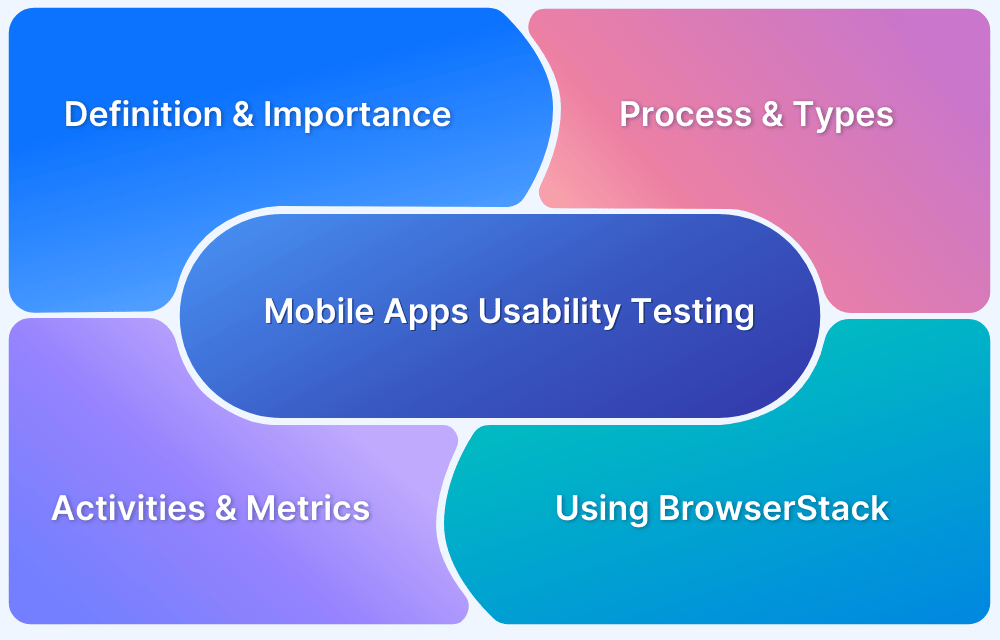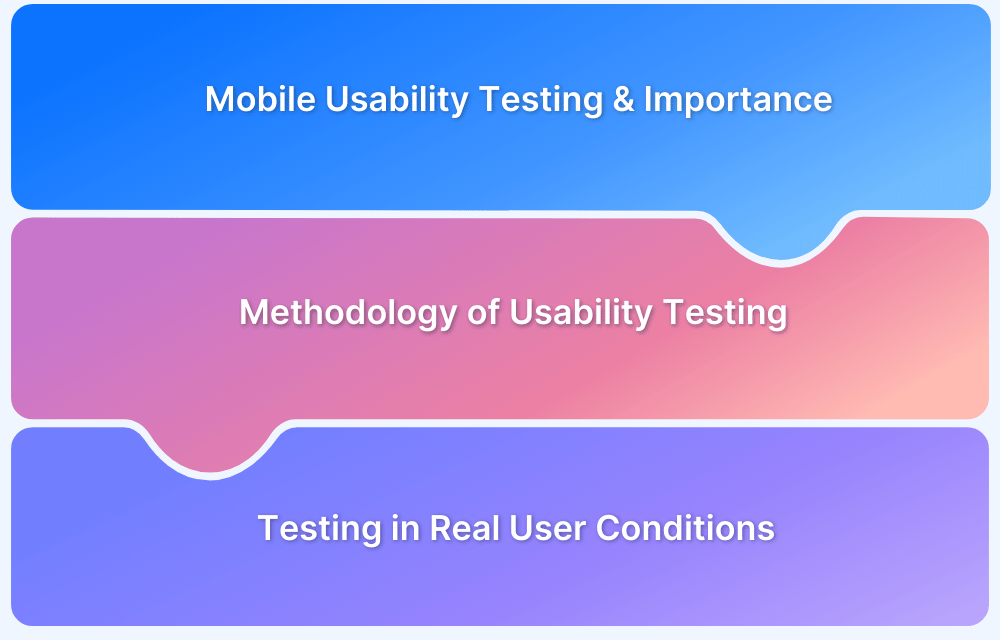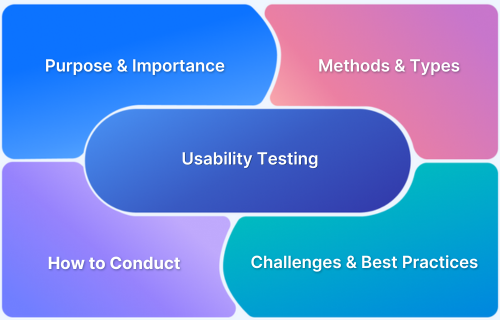Usability Testing measures how easy and user-friendly a software application is. End-users use the applications to expose usability defects during a session. Usability testing mainly focuses on the user’s ease of using the application, the flexibility of an application to handle controls, and the ability to meet its objectives.
This article will explore usability testing and best practices that will help you excel at it.
What is Usability Testing?
Usability testing is a research method that assesses how effectively real users can interact with a website or app. This testing allows design and product teams to evaluate a product’s intuitiveness and ease of use.
Usability testing is non-functional because it assesses how the product performs for the user(s). It also gauges the accessibility side of things with the application and checks if the users can complete some user journeys. Therefore, testing and validating whether the developed application is feasible is essential.
Factors to Consider for Usability Testing
Below are some key factors that should be considered for usability testing:
- Users should easily understand the main purpose of the application and its features
- Should be usable and accessible for all individuals, including those with disabilities, rather than targeting a specific demographic.
- Should be able to navigate through the app effortlessly, including the payment gateways.
Key Benefits of Usability Testing
The benefits of usability testing are given below:
- Helps improve end-user satisfaction
- Saves hours and money as it allows tests to be performed on users before going live
- Helps ensure the product will go live to the market as a successful one
- Makes your system highly effective and efficient
- Testing teams can discover opportunities and potential to improve the product interface and features based on user feedback
- Helps gather honest feedback from your target users who use your system during a usability test. You do not need to rely on “opinions” from random people.
How to Excel at Usability Testing
Given below are list of best practices that can help you excel at Usability testing:
- Varied Participant Group: Select test participants with a range of user backgrounds and skill levels.
- Utilize User Testing Tools: Leverage tools that offer insights into user behaviors and patterns.
- Authentic Scenarios: Design tasks that closely resemble real-life usage to gain valuable insights.
- Combination of Data Types: Evaluate both qualitative and quantitative data for a comprehensive understanding of the user experience.
- Testing for All Users: Implement accessibility checkers like Axe or WAVE to ensure the product is usable for individuals with disabilities.
- Continuous Testing: Create a schedule for regular usability testing throughout the development process to consistently integrate user feedback.
Why should the testing team be involved in usability testing?
As a software tester, it is vital to distinguish yourself between User Testing and Usability Testing, as they are different. The difference between user testing and usability testing is straightforward. User Testing is about “Will this user use my product?” Whereas usability testing is to understand “Can this user use this product?”. User research gives you a deeper understanding of users’ needs and behavior.
Usability testing mainly helps you find the usability issues in your design that you never expected. Both user research and usability testing are necessary for UX design which creates and enhances the quality of the user’s experience in a meaningful way.
The most heard statement in the testing world: “QA team is the closest to the users,” therefore, it’s vital to know how your users respond to the product you are developing. Things such as are the users have a comfortable experience, whether the application is smooth enough, it is easy to navigate, and easy to understand, how it feels to use the application, and how the application look are some of the curiosities testers always have and can use for usability testing.
The big question is how and where testers can implement this in their teams. The answer to this question is to start from where this could form part of a software development lifecycle. The suggestion is that you shift usability testing to the left, therefore, have conversations with the team and UX teams as soon as possible. You can start planning and researching earlier and then running the usability session once the iteration(iterations) of a functional application is ready. It is always a good idea to showcase something that is working. This way, users can express exactly what they feel and execute useful user journeys effectively.
How to Plan a Usability Testing Session.
When planning a session, start by defining a goal of the usability session, understand what is expected of the product, and how the product can also meet the user’s goal.
Similarly, think about the following too:
- The data flow
- The structure of the system
- Readability
- Maintainability
- The layout.
In usability testing, you can have two types of tests, Quantitative and Qualitative.
“Qualitative usability testing collects insights, findings, and anecdotes about how people use the product or service. Qualitative usability testing is best for discovering problems in the user experience. This form of usability testing is more common than quantitative usability testing.
Quantitative usability testing focuses on collecting metrics that describe the user experience. Two metrics most commonly collected in quantitative usability testing are task success and time on task. Quantitative usability testing is best for collecting benchmarks.”
QA and Usability Testing will always create a masterpiece of a product. We should know how to work closely with UX designers to develop the best-in-class product or software, aiming to focus solely on the quality of the application.
Remote vs. In-Person Testing
Usability testing can be done in two different formats, in person( in the office) or remotely with a special setup. Remote is less time-consuming and costs less than calling a set of users in person.
However, remote testing has two different types of testing: Remote moderated and Remote unmoderated.
“Remote moderated usability tests work very similarly to in-person studies. The facilitator still interacts with the participant and ask them to perform tasks. However, the facilitator and participant are in different physical locations. Usually, moderated tests can be performed using screen-sharing software like Skype or GoToMeeting.”
“Remote unmoderated remote usability tests do not have the same facilitator–participant interaction as in-person or moderated tests. The researcher uses a dedicated online remote-testing tool to set up written tasks for the participant. Then, the participant completes those tasks alone on their own time. The testing tool delivers the task instructions and any follow-up questions. After the participant completes their test, the researcher receives a session recording and metrics like task success.”
Usability Testing Checklist
To have a successful usability session, it could be a good idea for the testing team to have a checklist to execute the session successfully. Of course, the UX designer may be conducting this session and would have their script and checklist. However, a tester and UX designer’s checklist will be different.
Consider the following things to make the testing session a success:
- Shift Usability testing to the left and start planning this earlier in the development
- Try to write down questions that could be handy to ask during the session
- Do a practice session on a competitor’s product as a dry run as this could help you determine some standards for your target audience too
- Find out who will be joining the session ( experts of system, users, admin, non-expert)
- Play with different bandwidths with the users
- Focus on the critical and frequently used features
- Have one observing tester too who can only make notes of the session
- Showcase your results to the engineering team
Read More:– How to Perform Usability Testing for Mobile Apps
How can Browserstack support Usability testing?
- Identify and troubleshoot errors before your users have to deal with them by testing on a real device cloud. BrowserStack provides a robust combination of 3000+ real browsers and devices (latest and legacy) for manual and automated testing.
- Use real browsers and devices on BrowserStack. It doesn’t matter what emulator or simulator is being used; they will not offer 100% accurate results as they are not capable of replicating real user conditions.
- Test on a wide range of real devices such as iPhone, Samsung Galaxy, Pixel, Nexus, and more on multiple Android and iOS versions.
- Leverage 15+ native device features like GPS, network simulation, and localization to replicate real user scenarios.
- Interact with your mobile app on the remote device as you would with a device in hand. Tap, scroll, zoom, swipe, and more.
- Debug your app, view crash reports and logs, inspect UI elements, and use stack trace to fix bugs proactively.
- Test your native and hybrid apps out of the box on internal development and staging environments.
Conclusion
Usability testing is vital, especially to understand the user’s perception of the application and how they feel about it. By observing potential users interacting with a product, you can learn firsthand how it will work. Conducting usability testing in your teams enables you to effectively iterate and improve your product before and during development, reducing overall costs and increasing success when it’s time to go to market. You can, in turn, allow the results of usability testing to guide you to definitive answers to questions about your product:
- What will the application do?
- What features are most important for the users and the application?
- What should the application look like?
- How much will it cost to build?
- How long will it take?
After a round of usability testing, your team will revisit the pros and cons of product function, improving the prototype and product design based on test results. The cycle repeats itself as long as the budget and timeline allow before development.
Anyone creating a digital user-facing product should be aware of the importance of usability testing and collaboration with the UX team and include testers who can conduct their side of testing and make sure to do this in advance.






